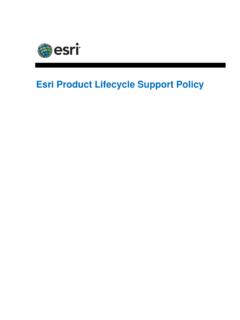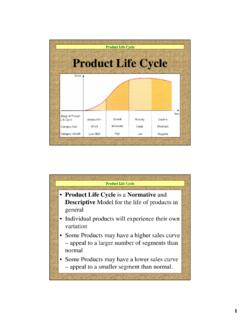Transcription of Lifecycle management: EU and US variation requirements
1 Regardless of a product s route or country of registration, one constant across the pharmaceutical industry is the requirement to keep dossiers updated and current. Whether changes are driven by technical and scientific improvements or cost reduction, post-approval Lifecycle management activities are a key responsibility of marketing authorisation holders (MAHs). As regulatory agencies across the world evolve, the methods of submitting and processing variations have begun to variationsAlongside the European legislation that defines variation types, a guideline lays out a harmonised list of anticipated variations with classification A defined list of variations for European MAs has existed since implementation of the Mutual Recognition Procedure (MRP) in 1998. However, the legislation governing European variation procedures was not fully adopted at the national level by many EU member states at that time. Legislation has periodically been updated and in the most recent update, in August 2013, implementation was made mandatory at the national level and the variation process has been completely harmonised across the EU.
2 The classification codes are as follows: Type IA/IAIN. Changes that fall under this category are commonly referred to as do and tell variations because the applicant is required to implement the change and then notify the agency of the details. This level of variation is reserved for administrative changes that are anticipated to have no impact on the safety or efficacy of a product . Variations that can be submitted as Type IA must be implemented and then the required submission made within one year of the implementation date. For changes that are categorised as Type IAIN the applicant must notify the agency within 14 days of implementation. Multiples of these variations for a single product can be made at the same time, as long as all of them fall within the required submission deadline. Type IB. Minor variations that require assessment of supporting data and are anticipated to potentially have an impact on product safety or efficacy are classified as Type IB.
3 These are also referred to as tell and do variations. The applicant must make the submission, including all required supporting data, and await agency approval before implementing the change. The process follows a defined assessment period of 30 days, but with agency questions it can often take up to three months. Type II. This classification is reserved for major variations which are expected to affect the safety and efficacy of a product and require careful assessment before the applicant can implement the change. Key points in regulatory management of variations Lifecycle management of pharmaceutical products varies between the EU and US in terms of different submission requirements and assessment timelines. However, similarities do exist in regional approaches to general categorisation of post-approval changes (variations) and in many cases also the principles of implementation. Post-approval variations in the EU and US can be administrative in nature, simple changes requiring minor review, or major changes which are often complex.
4 Administrative: EU regulators go as far as to define administrative as a category in their classification guideline, whereas in other regions they fall into the lowest variation category and have significant crossover with minor variations, eg new addresses. Many agencies accept that these changes can be implemented without the need for approval. Prior approval of administrative changes is time-consuming for agencies and costly for industry. Additionally, in certain cases such as a marketing authorisation holder (MAH) moving address, the change would actually need to take place prior to submission. Minor: Minor variations are generally considered to have either no impact on the quality of the product or have a very low chance of impact; and hence lower risk. Consequently, the level of agency review, and hence the time required is reduced. As regulatory frameworks have developed, agencies have introduced means to allow the most minor of variations to be implemented before review.
5 For example, in the EU, when a Type IA variation is submitted the MAH must state which of a pre-defined list of conditions applies to its change, thereby reducing the amount of review required. With minor variations, many agencies have documentation requirements that are well-established and must be met before variations are submitted. This ensures that MAHs know what is expected before a submission and can prepare sufficient supporting data. This leads to faster review times as assessors have less need to request further data from applicants. Major: Where notable alterations to product registration are required, these are expected to have an impact on a product s quality and efficacy and as such are tightly controlled, requiring in-depth assessment and review. The MAH must demonstrate that the product will retain the same level of quality and efficacy. Comparative data is a significant requirement for such changes and must reliably show the proposed changes do not impair product quality.
6 Assessment times for such variations are often much longer, as agencies carefully review submissions and frequently make requests for additional data and answers to questions and the need for variations and avoiding unnecessary variations is core to regulatory management of product lifecycles. This continuing development supplement the first in a quarterly lifelong learning series looks at the most common types of variations. It covers the European procedure for Type IA, Type IB and Type II variations, including line extensions, grouping and worksharing processes, versus the US, highlighting key similarities and differences. KEYWORDS: Lifecycle management; Post-approval; Variations; Harmonisation; Europe; US; Type IA/Type IB/Type II variations; Line extensionsLifecycle management: EU and US variation requirementsCPD withRegulatoryRapporteur Issue 1 (1), i-iv TOPRA require considerable supporting documentation and must be assessed and signed off by an appropriately qualified expert in their respected field before being submitted.
7 Line Extensions. Certain changes which affect the fundamentals of the terms of the authorisation cannot be granted via a variation and are submitted as an extension application : changes to the active substance(s); changes to strength, pharmaceutical form and route of administration. The invented name will remain the same for the extension .Post-approval changes in the USChanges to products licensed by the US FDA are achieved via the provision of supplements to the original new drug application (NDA). The supplements are as follows (see Table 1): AR: Annual Report. Changes that can be submitted in an annual report are of a minor nature and have minimal potential to effect quality, safety or efficacy of the product . The affected product can be distributed at any time after the change has been internally approved and before the details are reported in the Annual Report. At the end of a reporting period, any changes that have been implemented in the previous year are included together in a single notification to the agency.
8 CBE-0: Changes Being Effected 0. Changes classified as CBE-0 are minor (albeit moderate) changes to the product which can be implemented from when the FDA receives the supplemental NDA (sNDA) application. The product can also be distributed when the sNDA is received. CBE-0 changes are considered approved six months after receipt, if there are no technical issues raised by the FDA. However, if the change is not approved then distribution must cease and a product recall may be required. CBE-30: Changes Being Effected 30. Changes classified as CBE-30 are also deemed as minor (albeit moderate). Changes in this classification can be implemented and product distributed at risk, 30 days after the FDA receives the sNDA, unless the FDA notifies the applicant otherwise. Approval should be completed after six months. However, if the submission is rejected, a recall may also be required. PAS: Prior Approval Supplements. This category covers major changes that are considered to have a substantial potential to adversely affect the identity, strength, quality, purity or potency of the drug product .
9 product affected by these changes cannot be distributed until approval which should take up to four months, assuming there are no technical comparisonsThe definitions and terms used to describe variation types and processes vary across the regions, however, changes all fall into three general definitions which share many similarities: administrative, minor and major (as summarised in Table 1). The EU, in 2010, amended Type IA variations to be do and tell changes where the MAH may make the change before submitting a notification. When the guidelines were reviewed in 2013, certain existing Type IB variations with established requirements were downgraded to the level of Type IA where the authorities felt there was no impact on product quality. Quality implementation is when the company makes the change in its own Quality System. For product information, implementation is when the company internally approves the revised product information (which is then used in the next packaging run).
10 In cases where the variation assessment is unfavourable, the MAH must immediately cease applying the rejected variation . The Agency may ask the MAH to complete a suspected quality defect notification form and provide a risk assessment report for the product on the market. This concept appears to reflect the AR system seen in the US and has since been adopted by other agencies of EU variations is also possible via Grouping and also Workshare procedures, whereas in the US, multiple changes (eg, multiple study reports) can be filed under a single Activities to improve international harmonisation of Lifecycle management processes and guidelines allow agencies to share assessments and reduce individual workloads, improving their quality and speed of assessment. Such improvements are of considerable benefit to industry, seeing changes implemented faster and reducing the cost for many manufacturers. Finally, for regulatory professionals, it reduces the inevitable burden that stems from numerous national requirements and allows them to apply their skills and knowledge European Commission.




